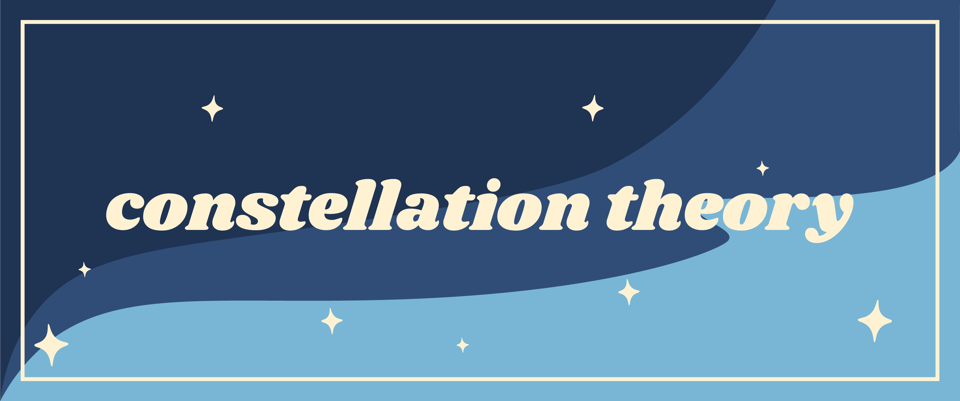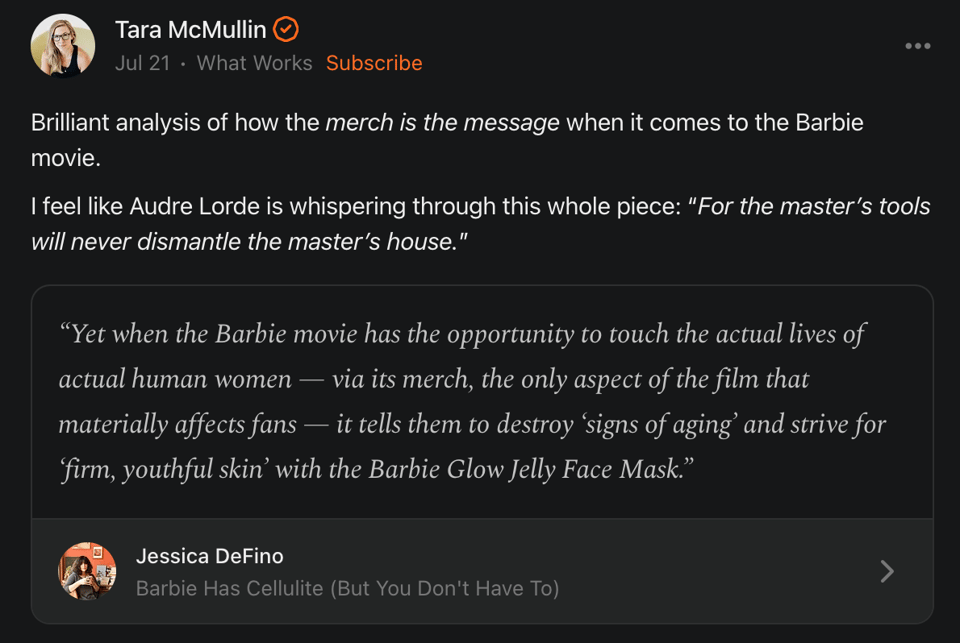note 01: hello universe! ✨
in my newsletter era

👋🏼 starting fresh
Welcome to my newsletter! My love of newsletters (and many attempts at writing one) is well-documented and familiar to longtime readers of my personal blog, but as I become a bit more protective of my personal life and a bit more public in my professional life, some people have asked me how they can follow my work. So here it is—first access to all of my writing, projects, and news (👀), delivered right to your inbox!
Most people in my professional network follow me because of my pop culture PowerPoint essays, but those take a long time to research and write! And I’ve always found great joy in sharing and discussing all of the scrap thoughts and observations about culture—the little in-between musings, the half-baked tangents that don’t merit a full essay (I love a good viral discourse moment and it’s one of the many things I miss about Twitter 🍸). So this newsletter will be all about the little cultural curiosities, a newsletter about “life, the universe, and everything.”
There will be no formal cadence. I’ve tried to keep a regular writing schedule before, and it always ends up stressing me out. Part of starting this newsletter is attempting to enjoy writing again, so instead it will be like a little treat that shows up in your inbox unexpectedly 🍬 enjoy!

✨ constellation theory origins
“Constellation theory” was one of those phrases that, as a writer, was always floating around in my head, a visual metaphor for the ways in which parts of culture intersect and interact with one another. From a distance, it’s difficult to discern any order in far-flung galaxies, this vastly infinite cosmos littered with stars. But the ancient Greeks believed that their heroes lived, immortalized, in the connections between the stars; they thought there were stories hidden in the empty spaces. And if you knew where to look, you could see the myths take shape. It was not sky full of randomly scattered, isolated stars but a tapestry of linked constellations, each placement deliberate, each star anchored exactly where it was supposed to be. The Chinese were some of the earliest and most meticulous astronomers, using star patterns to track time and tell fortunes. Indigenous cultures see the stars as an origin story, relating tales of the Star Woman who fell to Earth after seeing it from another dimension, beginning human life on the planet. Humans have always used constellations to guide us, to orient ourselves in the world.
To me, it perfectly illustrates my approach to thinking about both the world (philosophically) and about research and strategy (practically)—pulling from different disciplines to identify patterns and stitching them together into a cohesive narrative. I’ve always loved finding stories in data, though to call it “data” often strips it of its magic. But the best truths are uncovered by looking at both the macro and the micro, by indulging your curiosities, even the ones that feel inconsequential. And so I wanted to write a newsletter about my primary fascination: how we exist and why we exist, connecting the dots of culture and human behavior, understanding how we relate to each other and to the world around us. It’s the reason I got into advertising in the first place—to understand why people act the way they do.
But when I was Googling it, I found this article by BetterHelp about “family constellation therapy,” which was developed by German therapist Bert Hellinger in the ‘90s. It posits a systemic interpretation of trauma—in other words, that the effects of major events your ancestors lived through can trickle down to you.
From Wikipedia:
Hellinger referred to the relation between present and past problems that are not caused by direct personal experience as systemic entanglements, said to occur when unresolved trauma has afflicted a family through an event such as murder, suicide, death of a mother in childbirth, early death of a parent or sibling, war, natural disaster, emigration, or abuse.
It made me recall a class I took in college while completing my Literature and the Mind specialization, simply called “Body Language.” Much of the class focused on the manifestation of mental afflictions in the body, like psychosomatic injuries. But the overarching theme of the class was that the mind works in mysterious ways—we are always thinking, feeling, perceiving, processing, but you never know how these thoughts and feelings will resurface, how they shape you as a person. And that’s part of what psychology attempts to understand.
A year later, I went to the Museum of Tolerance in LA, and learned that trauma not only informs cognitive processes but actually changes the structure of the brain (what my Body Language professor referred to as “mental scaffolding”). As a result, these effects can be hereditary—being a descendant of a Holocaust survivor can profoundly affect your stress levels and make you more susceptible to PTSD.
It’s equally tragic and romantic, to view yourself as a living culmination of every butterfly’s wing flap, every moment of celestial alignment, every emotion your ancestors ever felt. But that’s how the mind (and the body) work. They are not separate entities but pieces of interlocking systems, notes in a composition perpetually being written and rewritten, stars bonding to one another in ways that may not be understood for billions of years.
It’s how culture works, too—everything is connected.

🌌 the big picture
I’ve tried to explain my job to my non-strategy, non-advertising friends and to my family, and the best I can come up with is: I translate lofty brand ideals into a language that resonates with real people (alternative that I love: being paid to fuck around and find out).
I’ve spoken at several strategy-related events about my “process,” and while I’m very honored to be asked, I’ve always felt that my approach to strategy is nothing radical. I simply subscribe to the idea that the best and most creative ideas come from having the time and space to idle and do other things that feel “unrelated” to the problem at hand—any artist will tell you the same.

Some of my best work has been inspired by serendipity. The meme linguistics deck my friend Anastasia and I made together (her book Cultural Intelligence for Marketers is out now!) was partly inspired by a random book launch at The Strand I attended five years ago. I wrote my Bitch Media piece about Hallmark Christmas rom-coms because of my annual tradition of buying a Peacock Premium subscription just for November/December so I can have campy holiday movies on in the background at all times. Another edition of this newsletter mentions something I found in a Harper’s BAZAAR interview with Natalie Portman and Julianne Moore, because I was looking for a reference clip from a movie on YouTube and fell into a celebrity interview rabbit hole. Two weeks ago I went to a BlackRock x Fidelity event about cryptocurrency, and a woman asked me, “Are you interested in digital assets?” and I answered that no, I was not, but I was interested to see what BlackRock and Fidelity think about digital assets. These things are technically unrelated to strategy, but it’s really about building a cultural repertoire that you can draw from. If you only read industry publications, your work will look like everyone else’s. So having the time and resources and brain space to create conditions for serendipity is so important. It’s not something a lot of agencies are willing to give strategists (one of the reasons I was happy to leave advertising). But it’s where the richest stories come from, including the ones written in the stars.
On that note: I’m soft-launching my cultural intelligence studio, so if you’re a brand or agency looking for smart insights and culturally fluent narratives to help you better connect with your audience, let’s chat! 💫
🔗 open tabs (recent reads)
“The 25 Most Defining Pieces of Furniture From the Last 100 Years“ (The New York Times): I am by no means a furniture enthusiast or anything (and my take is that education around this particular interest, as with so many other “refined” interests, is often limited by money and/or social class), but I do find broad-brush retrospectives like this fascinating. What constitutes “good” design is highly subjective, but a popular opinion is that good design should be invisible—it seamlessly blends into its environment—and a lot of iconic furniture, like the ergonomic office chair, is such, but only because it was so iconic that it was reinvented so many times and it’s become so ubiquitous. It’s cool to learn the origin of these things (did you know that that hip, colorful translucent plastic chair was originally designed as a modern interpretation of 18th-century French aristocratic design?) because that knowledge is what makes things like furniture inherently meaningful, before it’s imbued with our own meaning as part of our homes. My personal opinion is that furniture should be both functional and beautiful, and while I think this particular chair tests the boundaries of the former and is the opposite of the latter, I can appreciate that it is a defining piece. I also appreciate the fact that the curators made an effort to diversify the list beyond what experts consider “classic” (a word that often connotes Eurocentrism)—how can you possibly talk about defining pieces of furniture in the past century without acknowledging contributions from other parts of the world, when our own country is less than 250 years old?
“Everyone Is a Girl Online” (WIRED): I read an absurd number of takes on girlhood in preparation for The Bimbo Renaissance project I did, and I was prepared to roll my eyes when I saw that this one was written in September 2023 (very late in the year for the subject matter). I tend to read articles very fast, especially ones I find predictable, but this one demanded to be read slowly; the command of language was that impressive. And it dissects “girlhood” in a broad, existential way that I found really interesting and fresh.
“‘Past Lives’: A Tour of New York City With Greta Lee and Celine Song” (Rolling Stone): Past Lives was my favorite film of last year (you can read my collaboration with my friend Sean on its themes and why “romantic drama” is a bit of a mischaracterization here), and I love how Celine Song’s infatuation with New York City shines through. It reminds me of Begin Again (a criminally underrated favorite of mine)—the universal experience of wandering aimlessly through the city as a kind of therapy.
“Barbie Has Cellulite (But You Don’t Have To)” (The Review of Beauty): This is a succinct reminder of the cognitive dissonance of bimboism: “You cannot subversively, satirically, or ironically produce and consume things. The idea that you can is solipsistic and conservative. Production and consumption have collective consequences, whether you adopt Barbie-inspired beauty behaviors with a knowing wink or not!”

“What’s Ahead in 2024? The Cookie Cutters Tell All.” (The New York Times): This is exactly what “constellation theory” is all about, and this is what traditional syndicated research always misses. Always look at the ancillary industries, look for the unusual angles, look for what people actually care about! Data is everywhere, and sometimes it’s delicious.
💎 little gems (recent favorites)
The Traitors (Peacock): Up until recently, the only reality TV I’d ever watched was Survivor (ask me about my season rankings) and almost every show on Food Network, but I’ve since become more interested in reality TV. I watched The Golden Bachelor and Jury Duty and loved both because I found them such refreshing takes on the format and the hallmark of a new, kinder era of reality TV. And then I recently watched The Traitors because I still have Peacock Premium, and it’s basically a real-life game of Mafia or Among Us—a bunch of reality stars from different shows compete as team to win a pot of money (in a Scottish castle, hosted by Alan Cumming, with legitimately horrifying challenges), but there are several Traitors among them who are “murdering” Faithful players one by one, and they have to try to catch them. If there are any Traitors left in the game at the end, the Traitors take all. I loved watching the different styles of gameplay intersect from different reality shows—initially, I thought that Survivor players had the advantage, because they’re used to strategizing eliminations and completing challenges, but it’s a completely different game. On The Traitors, you’re lying constantly and so the paranoia is abundant, and it’s very easy to falsely accuse people based on tiny suspicions, so I actually think the Housewives have an advantage, because they’re accustomed to deflecting blame. I don’t know if I’ll ever be a Real Housewives or The Bachelor type of person but I do find reality TV fascinating as an anthropological study (so many behaviors related to social signaling and performance baked in!), and I’d love to learn more, so I welcome your recommendations!
Happy Medium: An “art cafe”—you pay $24 for two hours and you can choose your medium: clay, watercolor, collage, or charcoal. It’s so relaxing and instilled in me a peace I have not known in years (I’m only being a little dramatic). I have never been good at meditating but I love meditative things that let me switch off my brain and work with my hands—baking, doing puzzles, building furniture, and now, as I discovered, watercolor painting. And now there’s one in Greenpoint, which makes it much more convenient.
Sleep No More: I know I’m 13 years late to the party, but I finally pulled the trigger after seeing that it was closing. And I loved it so much that I immediately booked another ticket shortly after leaving. It’s a truly spectacular piece of live theater; I would love to know all about the mechanics of putting on a show like that, and I have so much respect for the actors who have to perform while navigating people shuffling around them, distractions galore. It has to involve a ridiculous amount of artistic discipline and technical capability. Sleep No More is classified as “immersive” theater vs. interactive—the actors don’t really respond to you, but rather act around you (you’re basically Patrick Swayze in Ghost). It’s difficult to explain to people who haven’t attended, but the whole experience takes place in a five-story “hotel” that you can wander around, while observing actors moving through the building performing a 1930’s film noir adaptation of Macbeth. It’s just as ambitious as it sounds, but the payoff is so worth it—it’s absolutely riveting. Tickets are definitely pricey ($160) but with the price of Broadway nowadays, I think it’s worth seeing at least once, especially since it’s closing (I can see why superfans go so many times, but it is definitely a dedicated expense)! If you can go before May 27th, I highly recommend it. Also, wear comfortable shoes. You want to follow the characters around the hotel to see their storylines play out and they will take off like bats out of hell—up stairs, down hallways, around rooms.
Merit Beauty Shade Slick Classics Tinted Lip Oil: It’s not an original take but it is a hot one: Most Gen Z’ers don’t really know what constitutes “good quality” and so most ultra-hyped products on TikTok are, frankly, very mid. A good example is lip products—so many branded “lip oils” are just lip gloss. Like, exactly the same as any Bonne Bell or generic clear soft plastic tube lip gloss we used to get in random gift sets as kids. If you were fancy, you upgraded to Victoria’s Secret or MAC. But it was all the same—super viscous and sticky and not moisturizing, in syrupy sweet flavors like Vanilla Cake and Mango Crush. My credentials are that I’m a mid-gen millennial who survived the 2015-2016 Instagram makeup era and the 2018-present skincare era who works in branding (so I know how to spot good marketing) and is now trying to restock my makeup collection (pandemic + turning 30 has altered my makeup habits). Merit’s is truly excellent; it’s weightless on the lips, but leaves behind a beautiful sheer wash of color while still delivering a decent amount of pigment and that juicy, summery look. I love the Sangria one; it’s a rich berry-wine color that’s really nice on its own but also gorgeous layered over a brown or pink-nude lip liner.
“Blue Monday” by Oliver Heldens & DJs From Mars (feat. JD Davis): The original New World Order song is one of my favorites, but this Oliver Heldens remix is so good. Best played on a loop while walking through the streets of New York—it makes you feel absolutely unstoppable. Honorable mention: the Cascada remix of Jax Jones’ “Never Be Lonely.” ’90s dance music is back, baby!
💖 jenny
Thank you to everyone who subscribed to this newsletter immediately after I launched it! Excited to be here with y’all. And a special thank you to my friend James Whatley who writes the excellent Five Things on Friday for recommending Buttondown as a Substack alternative (no support for Nazi apologists!)
Thanks for reading Constellation Theory ✨! Subscribe to receive new posts and first access to projects.
This newsletter will always be free. But if you’d like to support the publishing fees or just show some love and appreciation, you can buy me a coffee (or boba) here! 🧋
